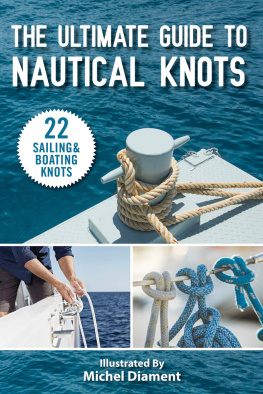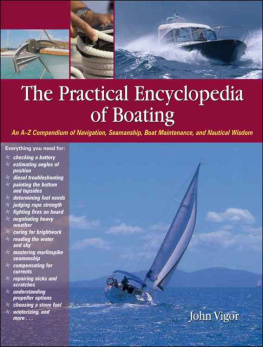Michelle Segrest - How to Speak Like a Sailor: 1500 Nautical Terms Every Mariner Should Know
Here you can read online Michelle Segrest - How to Speak Like a Sailor: 1500 Nautical Terms Every Mariner Should Know full text of the book (entire story) in english for free. Download pdf and epub, get meaning, cover and reviews about this ebook. year: 2021, genre: Adventure. Description of the work, (preface) as well as reviews are available. Best literature library LitArk.com created for fans of good reading and offers a wide selection of genres:
Romance novel
Science fiction
Adventure
Detective
Science
History
Home and family
Prose
Art
Politics
Computer
Non-fiction
Religion
Business
Children
Humor
Choose a favorite category and find really read worthwhile books. Enjoy immersion in the world of imagination, feel the emotions of the characters or learn something new for yourself, make an fascinating discovery.

- Book:How to Speak Like a Sailor: 1500 Nautical Terms Every Mariner Should Know
- Author:
- Genre:
- Year:2021
- Rating:3 / 5
- Favourites:Add to favourites
- Your mark:
- 60
- 1
- 2
- 3
- 4
- 5
How to Speak Like a Sailor: 1500 Nautical Terms Every Mariner Should Know: summary, description and annotation
We offer to read an annotation, description, summary or preface (depends on what the author of the book "How to Speak Like a Sailor: 1500 Nautical Terms Every Mariner Should Know" wrote himself). If you haven't found the necessary information about the book — write in the comments, we will try to find it.
Michelle Segrest: author's other books
Who wrote How to Speak Like a Sailor: 1500 Nautical Terms Every Mariner Should Know? Find out the surname, the name of the author of the book and a list of all author's works by series.
How to Speak Like a Sailor: 1500 Nautical Terms Every Mariner Should Know — read online for free the complete book (whole text) full work
Below is the text of the book, divided by pages. System saving the place of the last page read, allows you to conveniently read the book "How to Speak Like a Sailor: 1500 Nautical Terms Every Mariner Should Know" online for free, without having to search again every time where you left off. Put a bookmark, and you can go to the page where you finished reading at any time.
Font size:
Interval:
Bookmark:

If you want to learn to sail, the first step is to learn the language. Sailors communicate in a special way that can seem daunting for beginners. This book includes the Top 10 nautical terms every sailor should know and the most
common rules of engagement. Most important, the simple definitions of more than 1,500 nautical terms are included so that you can begin to get your sea legs and speak like a sailor right now!
HOW TO SPEAK LIKE A SAILOR
1500 NAUTICAL TERMS EVERY MARINER SHOULD KNOW
Compiled BY MICHELLE SEGREST
2021 Navigate Content, Inc., Alabama, USA.
All Rights Reserved.
Disclaimer
The information provided within this book is for general informational purposes only. The information was gathered through the combination of research, cited articles and resources, and the authors own experiences battling seasickness while sailing the world. The author is not a doctor and doesnt claim to give medical advice. Contained herein are the experiences and opinions of the author, combined with expert research, which is cited.
There are no representations or warranties, express or implied, about the completeness, accuracy, reliability, suitability, or availability with respect to the information, products, services, or related graphics contained in this book for any purpose.
No part of this book, including written passages, video content, and photographs, may be reproduced or transmitted in any form or by any means, electronic or mechanical, including photocopying, recording, or by any information storage and retrieval system, without written permission from the author.
Copyright 2021, Navigate Content, Inc.,
Alabama, USA.
All Rights Reserved

CONTENTS
TOP 10 NAUTICAL TERMS FOR BEGINNING SAILORS
1. Aft - The back of a ship. If something is located aft, it is at the back of the sailboat. The aft is also known as the stern.
2. Bow - The front of the ship is called the bow. Knowing the location of the bow is important for defining two of the other most common sailing terms: port (left of the bow) and starboard (right of the bow).
3. Port - Port is always the left-hand side of the boat when you are facing the bow. Because right and
left can become confusing sailing terms when used out in the open waters, port is used to define the left-hand side of the boat as it relates to the bow, or front.
4. Starboard - Starboard is always the right-hand side of the boat when you are facing the bow.
Because right and left can become confusing sailing terms when used out in the open waters, starboard is used to define the right-hand side of the boat as it relates to the bow, or front.
5. Leeward - Also known as lee, leeward is the direction opposite to the way the wind is currently blowing (windward).
6. Windward - The direction in which the wind is currently blowing. Windward is the opposite of leeward (the opposite direction of the wind). Sailboats tend to move with the wind, making the windward direction an important sailing term to know.
7. Boom - The boom is the horizontal pole which extends from the bottom of the mast. Adjusting the boom towards the direction of the wind is how the sailboat is able to harness wind power in order to move forward or backwards.
8. Rudder - Located beneath the boat, the rudder is a flat piece of wood, fiberglass, or metal that is used to steer the ship. Larger sailboats control the rudder via a wheel, while smaller sailboats will have a steering mechanism directly aft.
9. Tacking - The opposite of jibing, this basic sailing maneuver refers to turning the bow of the boat through the wind so that the wind changes from one side of the boat to the other side. The boom of a boat will always shift from one side to the other when performing a tack or a jibe.
10. Jibing - The opposite of tacking, this basic sailing maneuver refers to turning the stern of the boat through the wind so that the wind changes from one side of the boat to the other side. The boom of a boat will always shift from one side to the other when performing a tack or a jibe. Jibing is a less common technique than tacking, since it involves turning a boat directly into the wind.
1,500 NAUTICAL TERMS A TO Z
A
ABACK A sail is aback when the wind fills it from the opposite side to the one normally used to move the vessel forward.
ABAFT Toward the rear (stern) of the boat. Behind.
ABAFT THE BEAM Farther aft than the beam. A relative bearing of greater than 90 degrees from the bow.
ABANDON SHIP An imperative to leave the vessel immediately, usually in the face of imminent and overwhelming danger.
ABEAM At right angles to the keel of the boat, but not on the boat.
ABOARD On or within the boat.
ABOUT To change the course of the ship by tacking.
ABOVE BOARD On or above the deck. In plain view and not hiding anything.
ABOVE DECK On the deck.
ABOVE-WATER HULL The hull section of a vessel above the waterline. The visible part of a ship.
ABREAST Side by side; by the side of. To define abreast in non-sailing terms would be alongside something.
ABSENTEE PENNANT A special pennant flown to indicate the absence of a ships commanding officer.
ABSOLUTE BEARING The bearing of an object in relation to north. Also called True North.
ACCOMMODATION LADDER A portable flight of steps down a ships side.
ACCOMMODATION SHIP A ship or hull used as housing when there is a lack of quarters available ashore.
ACT OF PARDON or ACT OF GRACE A letter from a state or power authorizing action by a privateer. Also called a Letter of Marque.
ACTION STATION Battle stations.
ADMIRAL A senior naval officer of flag rank.
ADMIRALTY A high naval authority in charge of a states navy or major territorial component.
ADMIRALTY LAW The body of law that deals with maritime cases.
ADRIFT Loose, not on moorings or towline. Afloat and unattached.
ADVANCE NOTE A note for one months wages issued to sailors on their signing of a ships articles.
AFLOAT A vessel that is floating freely.
AFFREGHTMENT Hiring of a vessel.
AFORE Toward the front of a vessel.
AFT Toward the stern of the boat. The aft of a ship is towards the rear of the ship, or the back of a boat.
AFTERBROW On larger ships, a secondary gangway rigged in the area aft of midship.
AFTERDECK Deck behind a ships bridge.
AFTERGUARD Crew who work the aft sails on the quarterdeck and poop deck.
AFTERNOON WATCH The 12:00 to 16:00 watch.
AGROUND Touching or fast to the bottom.
AHEAD In a forward direction.
AHOY A cry to draw attention. Used to hail a boat or ship.
AHULL With sails furled and helm lashed to the lee side.
AIDS TO NAVIGATION (ATON) Artificial objects to supplement natural landmarks indicating safe and unsafe waters.
ALEE Away from the direction of the wind. Opposite of windward.
ALL HANDS When the entire ships crew, including officers, are enlisted to operate a mission or function.
ALL NIGHT IN When there are no night watches.
ALL STANDING An unforeseen or sudden stop.
Next pageFont size:
Interval:
Bookmark:
Similar books «How to Speak Like a Sailor: 1500 Nautical Terms Every Mariner Should Know»
Look at similar books to How to Speak Like a Sailor: 1500 Nautical Terms Every Mariner Should Know. We have selected literature similar in name and meaning in the hope of providing readers with more options to find new, interesting, not yet read works.
Discussion, reviews of the book How to Speak Like a Sailor: 1500 Nautical Terms Every Mariner Should Know and just readers' own opinions. Leave your comments, write what you think about the work, its meaning or the main characters. Specify what exactly you liked and what you didn't like, and why you think so.









